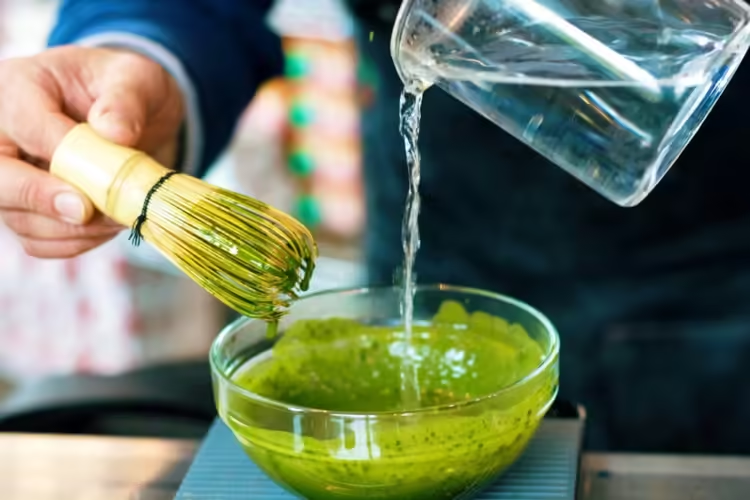

Get probably the most out of your matcha with these key suggestions from consultants at Ippodo Tea Co., Tealife Singapore, and extra.
BY MONICA MANANSALA
BARISTA MAGAZINE ONLINE
Featured picture by Jason Leung
For an in-depth dialogue of matcha’s historical past and performance within the café, see the article ”Sport Set Matcha” within the present problem—April + Could 2025—of Barista Journal!
Final week, we launched our information to creating high-quality matcha drinks at your café and shared suggestions from Tomoko Honda, head of world operations at Ippodo Tea Co. At present, we’ll discover extra recommendation on how one can get probably the most out of your matcha, and methods to make matcha a spotlight—not an afterthought—in your espresso store’s menu.
Correct Matcha Storage
Like espresso, matcha has correct storage protocol, and storing your matcha accurately can have a big effect on the way it tastes. Matcha is extremely delicate, and it’s greatest to maintain it in a spot away from direct contact with daylight, excessive temperatures, and humidity.
Hold your matcha powder in an hermetic, dark-colored container, away from gentle, moisture, and warmth. Refrigerating your matcha also can assist decelerate oxidation and delay its shelf-life. Matcha powder additionally simply absorbs odors, so that you’ll wish to retailer it away from some other substances with sturdy scents.


Selecting the Proper Matcha Bowl
In accordance with Tealife Singapore, your matcha bowl, also referred to as a chawan, needs to be bigger than an everyday cup or bowl—sufficiently big that you simply’ll wish to maintain it with two palms, moderately than one. Dimension is necessary right here, as a result of a wider base of your bowl will make it simpler so that you can whisk your matcha.
The form of your matcha bowl can also be one thing to pay thoughts to. A cylindrical form with thick, excessive partitions will assist keep the temperature of your matcha. You’ll additionally wish to be certain that your bowl has a rounded backside, and a easy floor moderately than a tough or bumpy one.


Milk Issues
Tomoko Honda of Ippodo Tea Co. shares with Barista Journal that the kind of matcha you select to make use of at your store shall be depending on different substances you have already got readily available, together with milk. However, she notes her hopes that matcha made with simply water, and no milk, will grow to be extra in style in Western cafés.
”It’s useful to discover a matcha that pairs properly with the milk you employ,” she says. ”That mentioned, I might like to see extra individuals uncover and admire the fantastic thing about conventional, straight matcha—simply whisked with water, in its purest type.”



The Which means of ”First-Harvest” Matcha
In half one of this information, we shared that buzzwords usually discovered on matcha labels, like “ceremonial-grade,” aren’t at all times significant. Nonetheless, there are key phrases to look out for in your labels that really do make a distinction.
For instance, most high-quality matcha drinks will use “first-harvest” matcha, which means the matcha was produced from the very first group of tea leaves harvested within the spring. The tea leaves from this primary harvest are the youngest and most tender, leading to a vibrant inexperienced colour and a extra complicated taste profile.



”The primary tea harvest within the yr (also referred to as first flush tea) is often the highest quality. It is because the tea crops are full of significant compounds saved over the course of winter,” Naoki Matcha shares in a weblog put up. ”When the brand new buds sprout in spring, these compounds and vitamins are concentrated in every of the brand new tea leaf buds. That is additionally why the primary harvest tea leaves comprise elevated ranges of helpful amino acids like L-theanine. … The L-theanine amino acid is accountable for the umami taste in shaded teas. With the primary harvest matcha containing probably the most L-theanine, it makes the tastiest matcha tea as in comparison with tea crops harvested later within the yr.”
Know Your Buyer
In the end, making an awesome matcha drink at your store means contemplating each your personal private style and that of your clients. Tomoko Honda argues that, on the finish of the day, the perfect matcha powder on your store shall be one which aligns with the expertise you want to create.
“Café house owners and baristas ought to select a matcha that fits their very own style and the expertise they wish to supply,” she says. “Greater value doesn’t at all times imply higher matcha—it actually comes right down to particular person taste preferences.”



And after six years of serving matcha at Ippodo’s New York Metropolis store, Tomoko has observed some clear preferences amongst Western clients. “In case your aim is to attraction to a large viewers, choosing a matcha with easy umami and minimal astringency is perhaps a great place to begin,” she says.
ABOUT THE AUTHOR
Monica Manansala is a espresso and matcha fanatic residing in Los Angeles. In her spare time, she enjoys cooking and spending time together with her cat.
Subscribe and Extra!
As at all times, you possibly can learn Barista Journal in paper or digital format. Subscribe right here to get your personal hardcopy of every problem delivered. Learn the April + Could 2025 problem at no cost with our digital version.
And for greater than three years’ value of points, go to our digital version archives right here.


